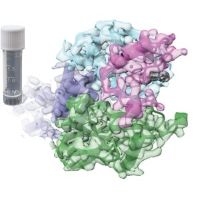Specification
| Description | Recombinant protein from the full-length sequence of Homo sapiens charged multivesicular body protein 4A (CHMP4A) (NM_014169). |
| Organism | Homo sapiens (Human) |
| Expression Host | Human Cells |
| Tag Info | His or DYKDDDDK. Please contact us if you need further information or require specific designed tag. |
| Purity | Greater than 90% by SDS-PAGE gel |
| Uniprot ID | Q9BY43 |
| Entry Name | CHM4A_HUMAN |
| Gene Names | CHMP4A C14orf123 SHAX2 CDA04 HSPC134 |
| Alternative Gene Names | C14orf123 SHAX2 |
| Alternative Protein Names | Charged multivesicular body protein 4a (Chromatin-modifying protein 4a) (CHMP4a) (SNF7 homolog associated with Alix-2) (SNF7-1) (hSnf-1) (Vacuolar protein sorting-associated protein 32-1) (Vps32-1) (hVps32-1) |
| Application | Antigens, Western, ELISA and other in vitro binding or in vivo functional assays, and protein-protein interaction studies; For research & development use only! |
| Buffer | Purified protein formulated in a sterile solution of PBS buffer, pH7.2, without any preservatives |
| Endotoxin | Endotoxin level is < 0.1 ng/µg of protein (<1EU /µg) |
| Length | 222 |
| Molecular Weight(Da) | 25098 |
| Protein Sequence | (The sequence of expressed protein may have some variation from the sequence shown below. Please contact us for the exact sequence.) MSGLGRLFGKGKKEKGPTPEEAIQKLKETEKILIKKQEFLEQKIQQELQTAKKYGTKNKRAALQALRRKKRFEQQLAQTDGTLSTLEFQREAIENATTNAEVLRTMELAAQSMKKAYQDMDIDKVDELMTDITEQQEVAQQISDAISRPMGFGDDVDEDELLEELEELEQEELAQELLNVGDKEEEPSVKLPSVPSTHLPAGPAPKVDEDEEALKQLAEWVS |
Background
| Function | FUNCTION: Probable core component of the endosomal sorting required for transport complex III (ESCRT-III) which is involved in multivesicular bodies (MVBs) formation and sorting of endosomal cargo proteins into MVBs. MVBs contain intraluminal vesicles (ILVs) that are generated by invagination and scission from the limiting membrane of the endosome and mostly are delivered to lysosomes enabling degradation of membrane proteins, such as stimulated growth factor receptors, lysosomal enzymes and lipids. The MVB pathway appears to require the sequential function of ESCRT-O, -I,-II and -III complexes. ESCRT-III proteins mostly dissociate from the invaginating membrane before the ILV is released. The ESCRT machinery also functions in topologically equivalent membrane fission events, such as the terminal stages of cytokinesis and the budding of enveloped viruses (HIV-1 and other lentiviruses). ESCRT-III proteins are believed to mediate the necessary vesicle extrusion and/or membrane fission activities, possibly in conjunction with the AAA ATPase VPS4. When overexpressed, membrane-assembled circular arrays of CHMP4A filaments can promote or stabilize negative curvature and outward budding. Via its interaction with PDCD6IP involved in HIV-1 p6- and p9-dependent virus release. CHMP4A/B/C are required for the exosomal release of SDCBP, CD63 and syndecan (PubMed:22660413). {ECO:0000269|PubMed:12860994, ECO:0000269|PubMed:14505569, ECO:0000269|PubMed:14519844, ECO:0000269|PubMed:14583093, ECO:0000269|PubMed:18209100, ECO:0000269|PubMed:22660413}. |
| Pathway | |
| Protein Families | SNF7 family |
| Tissue Specificity | Widely expressed. Expressed at higher level in heart, kidney, liver and skeletal muscle. Also expressed in brain, placenta, lung and pancreas. {ECO:0000269|PubMed:14678797}. |
QC Data
| Note | Please contact us for QC Data |
| Product Image (Reference Only) |  |

